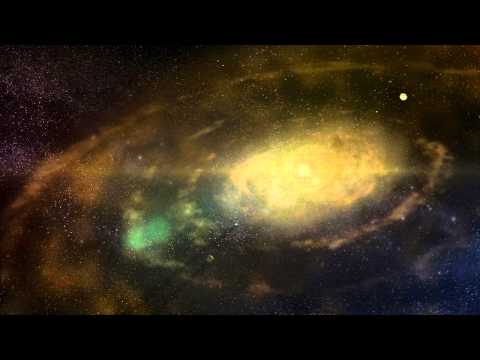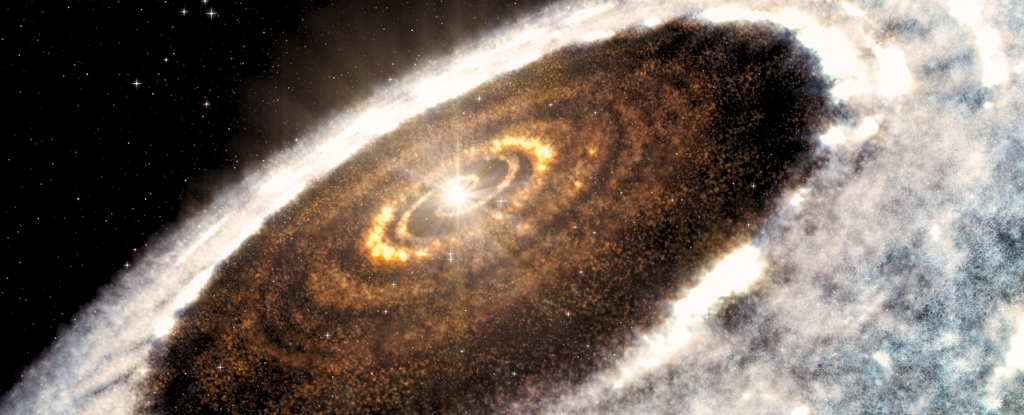Molecules capable of forming the precursors to sugars and amino acids have been detected, for the first time, in the disk of dust and gas whirling around a newborn star.
The detection is tentative, but it offers a window into how complex life gets its start from the chemistry in space, not just before planets are born, but even before the formation of the stars.
“Our results suggest that protoplanetary disks inherit complex molecules from earlier stages,” explains astrochemist Kamber Schwarz of the Max Planck Institute for Astronomy (MPIA) in Germany, “and the formation of complex molecules can continue during the protoplanetary disk stage.”
Related: The Building Blocks of Life Are Left-Handed, And The Reason Could Come From Deep Space
Stars and their planets are born from dense clouds of cold molecular gas and dust that drift through galaxies. When a clump of gas becomes dense enough, it collapses under its own gravity to form a spinning, dense mass.
Material continues to fall in from the cloud as the newly formed sun grows, angular momentum forcing surrounding dust to arrange itself in the shape of a disk that spools into and feeds the star.
Eventually, stellar winds and radiation pressure will push the material away from gravitational reach; what’s left of the disk is what the planets form out of. You are literally made of star leftovers… that’s a fun thought.
The processes involved in this formation, in addition to rampant flare activity from a tempestuous new star, have been considered a barrier to the survival of biomolecules within the protoplanetary disk. Thus, any biomolecules that contribute to planet formation must, in theory, have formed after the star has undergone its destructive shenanigans.
This brings us to a still-forming protostar called V883 Orionis, a star about 1,350 light-years away that is still in its destructive phase. Using the Atacama Large Millimeter/submillimeter Array (ALMA) in Chile, a team led by MPIA astronomer Abubakar Fadul has studied the spectrum of light, and found evidence of at least 17 complex organic molecules.
Those molecules include ethylene glycol (a simple sugar alcohol from which more complex molecules can form) and glycolonitrile (a precursor of the amino acids glycine and alanine, and the nucleobase adenine).
Their presence in the protoplanetary disk of an outbursting protostar suggests that they are inherited from the molecular cloud, filling in an evolutionary gap between pre- and post-stellar disk biochemistry.
 frameborder=”0″ allow=”accelerometer; autoplay; clipboard-write; encrypted-media; gyroscope; picture-in-picture; web-share” referrerpolicy=”strict-origin-when-cross-origin” allowfullscreen>
frameborder=”0″ allow=”accelerometer; autoplay; clipboard-write; encrypted-media; gyroscope; picture-in-picture; web-share” referrerpolicy=”strict-origin-when-cross-origin” allowfullscreen>“Our finding points to a straight line of chemical enrichment and increasing complexity between interstellar clouds and fully evolved planetary systems,” Fadul says.
The conditions under which these molecules form are very cold ones. The researchers believe that they formed on ice grains in the cloud, which then clumped together, forming icy objects with the molecules locked inside. As the baby star grew, its increasing heat sublimated the ice, releasing the molecules from within, to drift in the disk where their signature could be detected by ALMA.
Even so, the signal was a small one, and is going to require higher resolution observations at longer wavelengths. These won’t just confirm the molecules that the researchers have already found, they’ll also identify new ones. The researchers are particularly keen to see if they can find molecules containing nitrogen, which were curiously low in the ALMA data.
“Perhaps we also need to look at other regions of the electromagnetic spectrum to find even more evolved molecules,” Fadul says. “Who knows what else we might discover?”
The research has been published in The Astronomical Journal.
